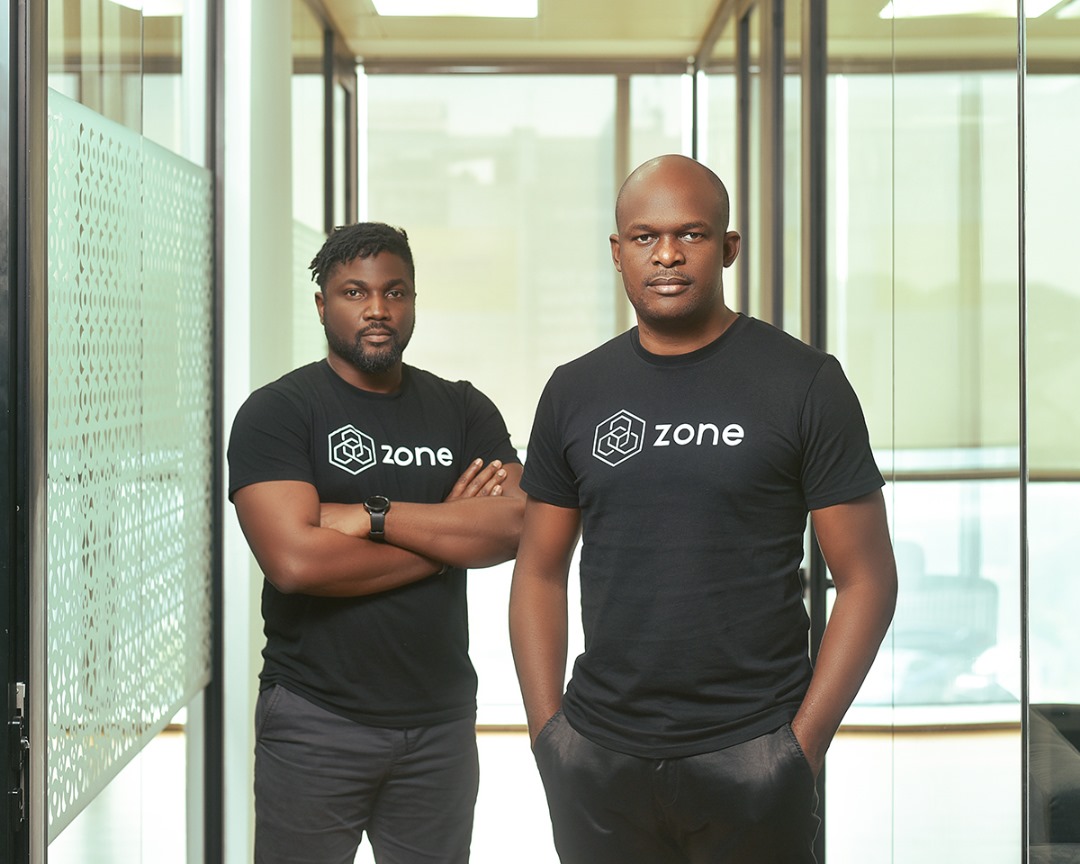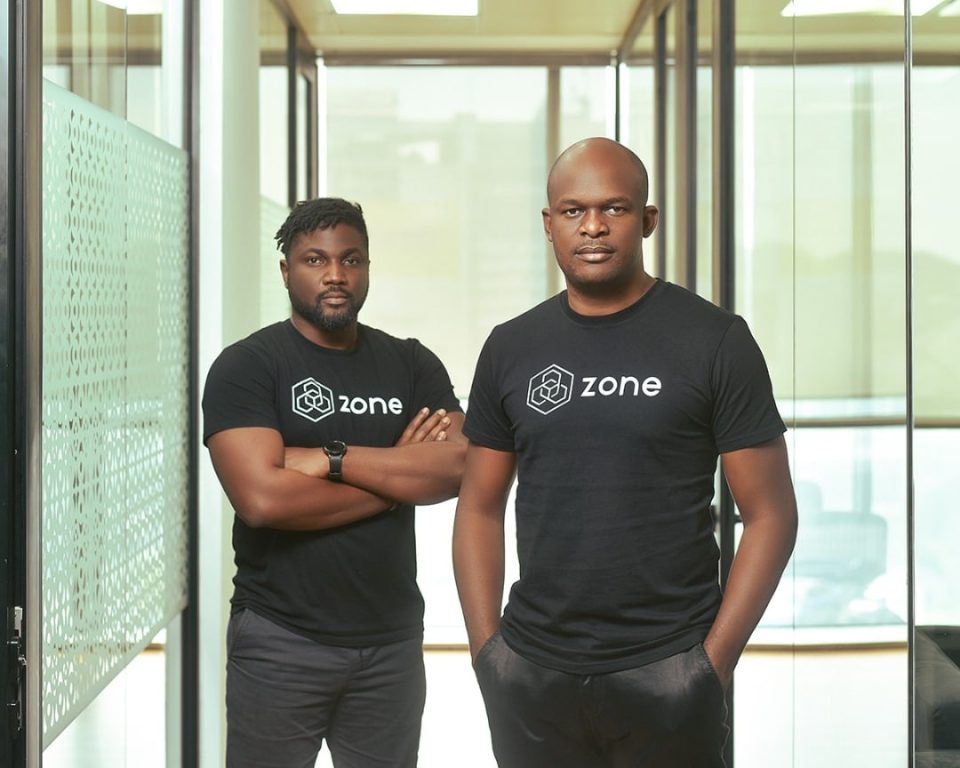
Left to right: Wale Onawunmi (Co-Founder & CTO Zone) Obi Emetarom ( Co-Founder & CEO Zone)
If the Central Bank of Nigeria (CBN) had financial oversight over Ethereum or Solana, anyone launching a token on these blockchains or building a DeFi product would have to follow its rules.
Instead of paying gas fees in ETH, we would pay in naira. Ethereum would still function the way it was designed to, but the government would be able to see everything happening on the blockchain.
This is one way to think about the blockchain future that Zone is proposing. A global financial ecosystem powered by blockchain where regulation and compliance are embedded into the network.
This concept is a bigger picture compared to what Zone already does. As a blockchain payment company, it created a regulated blockchain network that allows financial institutions to facilitate payments among themselves without going through a third party.
This third party is a payment switch, like Interswitch or eTranzact. They can be seen as an interpreter between two people who do not speak the same language; they communicate between both banks, facilitate transactions, and keep records.
However, this process makes it a hassle to resolve transaction errors. According to Zone CEO, Obi Emetarom, the switch has to communicate with both banks to figure out what happened.
With Zone, however, all banks are within the same regulated blockchain network and cannot only communicate directly but also see the state of transactions on both ends.
The white paper Emetarom authored builds on this concept, but with even loftier dreams. In 2024, I described Zone’s innovation as the best thing since the creation of the Nigeria Inter-Bank Settlement System (NIBSS), but with this direction, Zone wants to alter the entire global financial infrastructure.
Why a regulated blockchain infrastructure matters
A regulated blockchain is Zone’s answer to the battle between innovation and oversight. Imagine a blockchain where every smart contract, token, and transaction is not only visible to regulators in real-time but also runs according to the rules that regulators helped write in code.
In a way, it’s still decentralised, tamper-proof, and fast, but it’s also built with compliance baked into its DNA.
In simple terms, it’s like building a financial system where the law is the software, and every player — from fintech startups to central banks — operates on the same trusted infrastructure.
Zone believes that a regulated blockchain matters because the current financial landscape is inefficient on both the traditional and blockchain sides.
According to the white paper, traditional finance (TradFi) is slow, costly, opaque, and riddled with intermediaries, making it difficult to innovate. Meanwhile, decentralised finance (DeFi), though fast and flexible, lacks the regulatory oversight needed to gain institutional trust or mainstream adoption.
By combining the security, transparency, and programmability of blockchain with real-time, on-chain regulation, Zone wants to create a third path where financial services are compliant by default.
More importantly, Zone sees regulated blockchains as the key to unlocking a Golden Age of finance where users control their assets, AI agents manage money on their behalf, and every financial product operates transparently and without human interference.
According to Emetarom, “Combining regulation with blockchain is the future of financial services.”
In this future, regulators aren’t fighting innovation; they’re embedded in it.
How will a regulated blockchain work?
Zone’s regulated blockchain will be similar to existing blockchains like Ethereum, with the key difference being regulation.
In the model Zone is proposing, only approved organisations, such as licensed entities and government regulators, can build apps, issue tokens, or run the computers called validator nodes that keep the network running.
AI automatically screens these apps and tokens to make sure they follow rules such as identity verification, anti-money laundering, and consumer protection.
Regulators don’t just audit from the outside; they’re inside the network, running nodes, approving products, and monitoring activity in real-time.
This means every transaction, app, and financial product is compliant by default, unlike on Ethereum, where compliance is left entirely to users or happens off-chain.
Another big difference is self-custody with safeguards. Like Ethereum, users control their wallets and assets. No bank or company holds their funds. But on the regulated blockchain, the tokens are pegged to real money like central bank digital currencies (CBDCs) or naira, and every action is monitored by rules programmed into the blockchain
Essentially, the freedom that comes with blockchain is combined with the safety of regulated systems. Instead of using volatile tokens like ETH or BTC for fees, Zone uses stable, government-approved tokens that represent actual fiat currency.
What would this look like in the real world?
The idea for a regulated blockchain network is a large, open-source network where regulators and other approved participants can contribute and make compliant changes.
“A regulated blockchain would be like an Ethereum where different participants would be products — whether it is a B2C payment product, lending, investment, or even insurance — and run them on this compliant environment,” says Emetarom.
“The lending process can be a bit obscure; you can have situations where bad loans are given out, and those loans can be recovered, but sometimes it’s difficult to tell the extent.”
On the crypto side, DeFi lending protocols try to solve this with automation. In these systems, users fund lending pools, and smart contracts handle the process of distributing loans. But even that has its problems.
“The challenge is that the smart contracts running those lending products can’t be completely trusted. Yes, you can study it and see that it’s open source. But not everybody can read code.”
This means that malicious developers can hide backdoors or dishonest logic in the contract, and most users won’t notice until their funds are gone.
The absence of active oversight means that even though the system is transparent in theory, it’s inaccessible in practice for most people.
A regulated blockchain lending model seeks to bridge this gap, offering the automation of DeFi with the safety and structure of traditional finance.
“You have a lending pool run by smart contracts so you avoid the risk of misappropriation tied to human intervention.”
No one can manually interfere with the funds or processes. The smart contract executes loans strictly according to predefined rules, reducing the risk of human fraud or mismanagement.
But automation alone isn’t enough; regulation also needs to come into play somehow.
“The risk of the behaviour or the logic is now managed by the fact that the smart contract is regulated.”
Before any smart contract can be deployed to the blockchain, it will be screened by both regulators and automated systems to ensure the code is clean, fair, and non-malicious.
“Your blockchain is immutable, meaning that once that is done and deployed, even the service provider cannot go back to tamper with it.”
seIf changes ever need to be made, they must go through the same screening process again. This ensures that lending services remain safe, transparent, and compliant.
Zone’s propositions appear promising. It could be one way for the Securities and Exchange Commission (SEC) to enforce its rules and guidelines. It will embed these guidelines into the infrastructure, and regulation becomes a piece of cake. Token issuers, for example, need only to deploy on the blockchain, and they’re automatically compliant.
However, these propositions may not see the light of day. Projects like Hyperledger, R3 Corda, and Quorum were early attempts at permissioned blockchains for banks and enterprises.
They promised secure, regulated blockchain infrastructure, but most ended up confined to pilot projects, private consortia, or niche use cases.
Lack of interoperability is one reason for this, but Emetarom points out that Zone now supports solidity smart contracts, which means that applications built on Ethereum can work on Zone.
This could solve the problem of interoperability, but the main problem — politics — cannot be solved with technology. Regulators from different African countries have already admitted that the issue with instant cross-border payments in Africa is deeper than technology.
The success of Zone’s propositions hinges on factors beyond its control, but if it can surmount the political challenge, it would be interesting to see if these theories can become reality.
